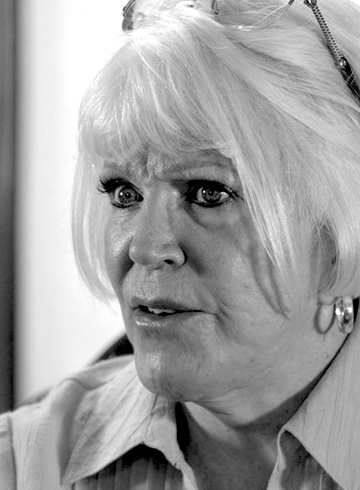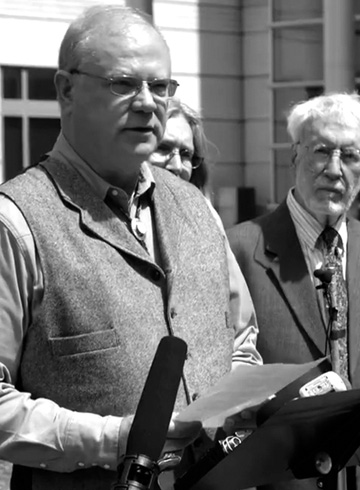Logline

“In the suburbs of Denver, a top-secret nuclear bomb plant operated for decades, leaving a toxic legacy that still haunts the community today."
Synopsis
The Rocky Flats nuclear weapons plant churned out a staggering 70,000 atomic bombs, known as “triggers,” for the U.S. nuclear arsenal. Behind a veil of government secrecy, fires, leaks, and illicit dumping of hazardous materials contaminated the Denver area with radioactive and toxic substances.
In 1969, a significant plutonium fire marked a turning point, prompting a group of local citizens to embark on a grassroots campaign to unveil the imminent threat of nuclear weapons production at Rocky Flats. By 1978, the protests had grown to massive levels, attracting thousands of people who demanded the closure of the plant. "
Mass protests continued for over a decade and reached a pivotal moment in 1989, when the FBI executed an unprecedented raid at Rocky Flats, effectively shuttering the bomb plant. The extraordinary raid uncovered evidence of environmental contamination, conspiracy, and cover-ups. However, a special federal grand jury was thwarted when they attempted to hold officials accountable.
A ten-year multi-billion-dollar cap-and-cover effort was declared complete in 2005, and a national wildlife refuge now overlays the Rocky Flats site. "The Most Dangerous Buildings In America" rest silently beneath six feet of soil at the center of the refuge, concealing a landscape still saturated with residual contamination.
Today, the radioactive legacy of Rocky Flats is invisible to the naked eye. New housing developments are engulfing areas known to be contaminated with radioactive plutonium. Thousands of former Rocky Flats workers have suffered devastating consequences from radiation contamination. Community members are determined to uncover a potential link between Rocky Flats and alarming health reports in the surrounding neighborhoods. Numerous lawsuits, continued deception, health concerns, and ongoing contamination issues continue to plague Rocky Flats, yet the public is largely unaware of Rocky Flats' past and its long-lasting radioactive effects. State and Federal officials claim the area is safe, however, the lasting repercussions of Rocky Flats on the Denver area remain uncertain, as plutonium has a half-life of 24,000 years
Trailer
Select Interviews

Judy Padilla is a former Rocky Flats worker, cancer survivor, and widow. Padilla worked on the front lines of Rocky Flats production, forming plutonium “triggers” inside steel encased gloveboxes. After developing cancer, Padilla took six months off work for surgery and returned to Rocky Flats until its closure in 2005. Her husband, Charlie, also worked at Rocky Flats and passed away from cancer in 2002. Judy has been an advocate for sick nuclear works and an outspoken critic of Rocky Flats’ reopening as a national wildlife refuge.
Judy Padilla
Former Rocky Flats Worker
and cancer survivor

Jon Lipsky is a retired FBI agent and former police officer. Lipsky led the unprecedented FBI raid on the Rocky Flats nuclear weapons plant in 1989. His investigation exposed mass pollution, cover-ups, and illegal dumping of nuclear waste at Rocky Flats, leading to the permanent closure of the facility and a halt in U.S. atomic bomb production. Lipsky later emerged as a notorious whistleblower for Rocky Flats, taking early retirement from the FBI to expose the hidden secrets of Rocky Flats to the public.
Jon Lipsky
Former FBI agent who led the
raid on Rocky Flats in 1989

Wes McKinley is a rancher and former schoolteacher from southeastern Colorado. In 1992, he was thrust into an unexpected role as the foreman of a Special Federal Grand Jury investigating crimes at Rocky Flats. Alongside his fellow jury members, McKinley was outraged by the Justice Department's dismissal of their pleas for criminal prosecution against the plant operators. Fueled by a desire for truth, the jury broke their oath of secrecy to go public and expose the perilous nuclear contamination at Rocky Flats. Since then, Wes McKinley has emerged as an enduring whistleblower on a mission to warn the public about Rocky Flats.
Wes mcKinley
Grand Jury foreman and
former Colorado Representative

Dr. Mark Johnson has been the public health director of Jefferson County since 1989. Dr. Johnson came forward with concerns about opening Rocky Flats as a national wildlife refuge and allowing housing on nearby contaminated lands. His detractors have labeled him the “General of the Scare Brigade” for his public denunciation of Rocky Flats; however, he continues to advocate for the health and safety of nearby residents.
Dr. Mark Johnson
Public health director
for Jefferson County

Tiffany Hansen grew up just downwind of the Rocky Flats nuclear weapons plant. After experiencing health issues and learning about a possible link to nuclear waste, she began reaching out to friends and found that many of her peers also had illnesses. She launched the Rocky Flats Downwinders campaign, in 2015, which has plotted over 900 incidents of cancer in the local community. She continues to educate the public and is determined to uncover a potential link between Rocky Flats and the alarming health reports in surrounding neighborhoods.


























